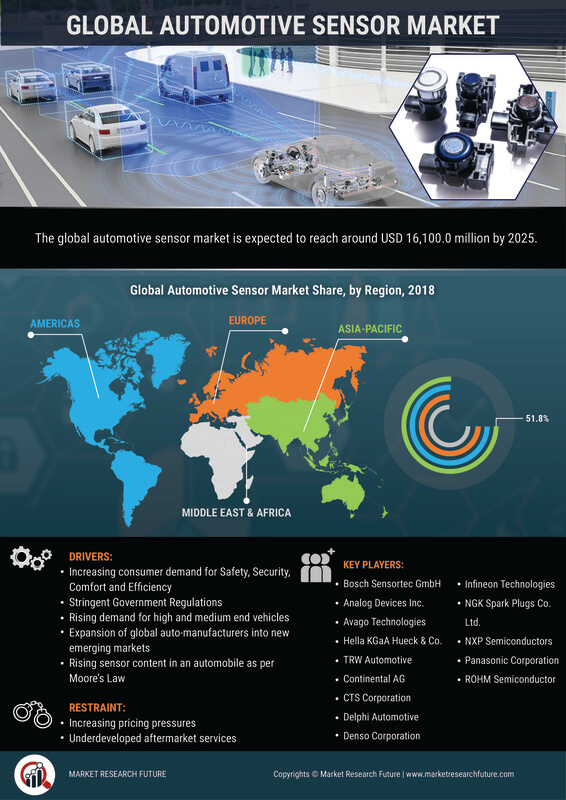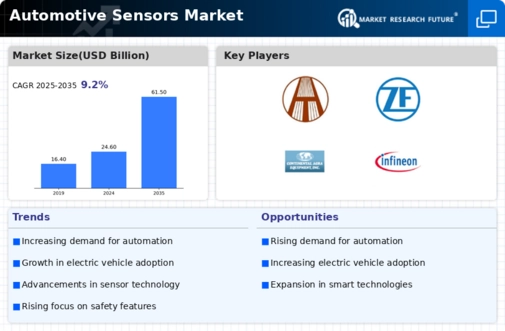Regulatory Compliance
Regulatory compliance is a significant driver for the Global Automotive Sensors Market Industry, as governments worldwide impose stringent safety and environmental regulations. For instance, the European Union has mandated the installation of advanced driver-assistance systems (ADAS) in new vehicles, which necessitates the use of various sensors. This regulatory push is expected to contribute to the market's growth, with projections indicating an increase to 61.5 USD Billion by 2035. Compliance with these regulations not only enhances vehicle safety but also promotes the adoption of innovative sensor technologies, further driving market expansion.
Consumer Safety Awareness
Consumer safety awareness is increasingly shaping the Global Automotive Sensors Market Industry. As individuals become more informed about vehicle safety features, there is a growing demand for advanced safety technologies, including sensors that support features like lane departure warnings and automatic emergency braking. This heightened awareness is likely to drive market growth, as manufacturers prioritize the integration of such technologies into their vehicles. The emphasis on safety not only enhances consumer confidence but also aligns with regulatory trends, further propelling the market forward in the coming years.
Market Growth Projections
The Global Automotive Sensors Market Industry is poised for substantial growth, with projections indicating a rise from 24.6 USD Billion in 2024 to 61.5 USD Billion by 2035. This growth trajectory reflects a compound annual growth rate (CAGR) of 8.68% from 2025 to 2035, underscoring the increasing reliance on sensors in automotive applications. The expansion of the market is driven by various factors, including technological advancements, regulatory compliance, and the growing demand for electric vehicles. These dynamics collectively suggest a robust future for the automotive sensors sector.
Technological Advancements
The Global Automotive Sensors Market Industry is experiencing rapid technological advancements that enhance vehicle safety and efficiency. Innovations in sensor technology, such as LiDAR and advanced radar systems, are becoming increasingly prevalent. These technologies improve functionalities like adaptive cruise control and collision avoidance systems. As a result, the market is projected to reach 24.6 USD Billion in 2024, driven by the demand for smarter vehicles. Furthermore, the integration of Internet of Things (IoT) capabilities into automotive sensors is likely to create new opportunities for growth, as vehicles become more connected and automated.
Growing Demand for Electric Vehicles
The shift towards electric vehicles (EVs) is a pivotal factor influencing the Global Automotive Sensors Market Industry. As the automotive sector transitions to electrification, the need for advanced sensors to monitor battery performance, thermal management, and energy efficiency becomes paramount. This trend is likely to propel the market, with a projected compound annual growth rate (CAGR) of 8.68% from 2025 to 2035. The increasing adoption of EVs is expected to drive demand for specialized sensors, thereby creating new avenues for manufacturers and suppliers within the automotive sensor landscape.
Integration of Advanced Driver Assistance Systems
The integration of advanced driver assistance systems (ADAS) is a crucial driver for the Global Automotive Sensors Market Industry. ADAS relies heavily on various sensors, including cameras, ultrasonic sensors, and radar, to enhance vehicle safety and automation. As automakers increasingly incorporate these systems into their vehicles, the demand for automotive sensors is expected to rise significantly. This trend is indicative of a broader shift towards automation in the automotive sector, which is likely to contribute to the market's growth trajectory, reinforcing the importance of sensors in modern vehicle design.





